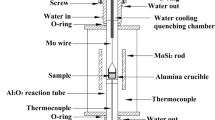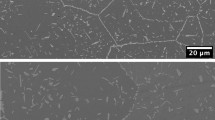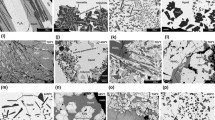Abstract
The activities in liquid Fe-V-0 and Fe-B-O alloys have been determined using the following galvanic cells Cr-Cr2O3(s) | ZrO2(CaO) | Fe-V-O (l, saturated with oxide) Cr-Cr2O3(s) | ThO2(Y2O3) | Fe-V-O (l, saturated with oxide) Cr-Cr2O3(s) | ZrO2(CaO) | Fe-B-O (l, B2O3 saturated with Al2O3) The solubility of oxygen in Fe-V alloys at 1600°C decreases with increasing vanadium content to a minimum of about 180 ppm at 3 wt pct V, and then increases to over 4000 ppm at 36.3 wt pct V. Vanadium was found to decrease the activity coefficient of oxygen and the value of the interaction coefficient eo V at infinite dilution of vanadium is -0.14. The activity of vanadium was calculated from the measured electromotive force, and log γv was found to be represented well by the quadratic formalism for Nv < 0.4: log γV = -0.70N 2 Fe -0.30 At 1550°C boron decreases the solubility of oxygen down to about 80 ppm at 0.67 wt pct B in Fe-B melts in equilibrium with B2O3 saturated with A12O3 (NAl 2 O3 = 0.087). The boron deoxidation product, ’K′ = (wt pct B)2(wt pct 0)3 at infinite dilution of boron is 4.4 × 10-9 and 1.5 × 10-8 at 1550° and 1600°C, respectively. Boron decreases the activity coefficient of oxygen in liquid iron, and the value of the interaction coefficient eo B is -2.6 at infinite dilution of boron. The activity coefficient of boron at infinite dilution (γ° B) is 0.083 at 1550°C relative to solid boron.
Similar content being viewed by others
References
M. Dastur and J. Chipman:AIME Trans., 1951, vol. 191, pp. 111–15.
H. Schenck and E. Steinmetz:Arch. Eisenhuettenw., 1967, vol. 38, pp. 871–74.
J. K. Pargeter:Can. Met. Quart., 1967, vol. 6, pp. 21–36.
W. A. Fischer and M. Haussmann:Arch. Eisenhuettenw., 1966, vol. 36, pp. 959–61.
G. Derge:AIME Trans., 1946, vol. 167, pp. 93–107.
R. J. Fruehan, L. J. Martonik, and E. T. Turkdogan:Trans. TMS-AIME, 1969, vol. 245, pp. 1501–10.
J. F. Elliott, M. Gleiser, and V. Ramakrishma:Thermochemistry for Steelmaking, Vol. II, Addison-Wesley, 1963.
Basic Open Hearth Steelmaking, AIME, 1964.
R. J. Fruehan:Met. Trans., 1970, vol. 1, pp. 865–70.
R. J. Fruehan:Trans. TMS-AIME, 1969, vol. 245, pp. 1215–18.
E. M. Levin, C. R. Robbins, and H. F. McMurdie:Phase Diagrams for Ceramists, The American Ceramic Society, 1964.
P. J. Gielisse and W. R. Foster:Nature, 1962, vol. 195, pp. 69–70.
C. H. P. Lupis and J.F. Elliott:Acta Met., 1966, vol. 14,pp. 529–38.
L. S. Darken:Trans. TMS-AIME, 1967, vol. 239,pp. 80–89.
L. S. Darken:Trans. TMS-AIME, 1967, vol. 239, pp. 90–96.
R. Hultgren, R. Orr, P. Anderson, and K. Kelley:Selected Values of Thermodynamic Properties of Metals and Alloys, J. Wiley & Sons, New York, 1963.
K. Myles and A.T. Aldred:J. Phys. Chem., 1964, vol. 68, pp. 64–69.
Author information
Authors and Affiliations
Rights and permissions
About this article
Cite this article
Fruehan, R.J. Activities in liquid Fe-V-O and Fe-B-O alloys. Metall Trans 1, 2083–2088 (1970). https://doi.org/10.1007/BF02643418
Received:
Issue Date:
DOI: https://doi.org/10.1007/BF02643418




